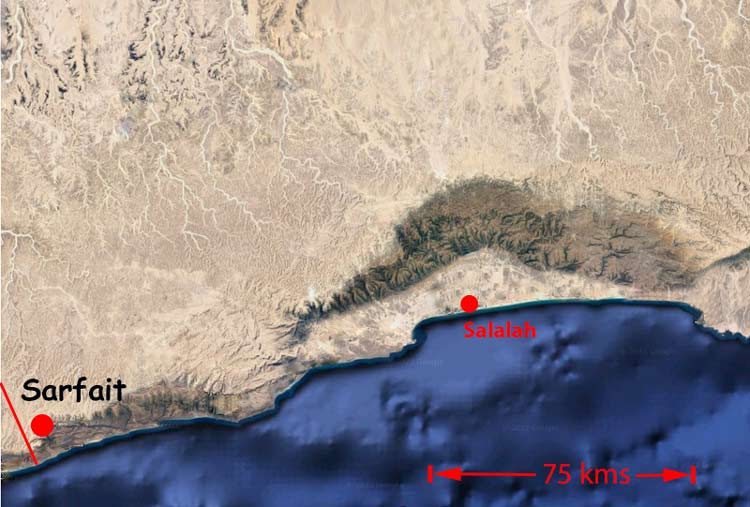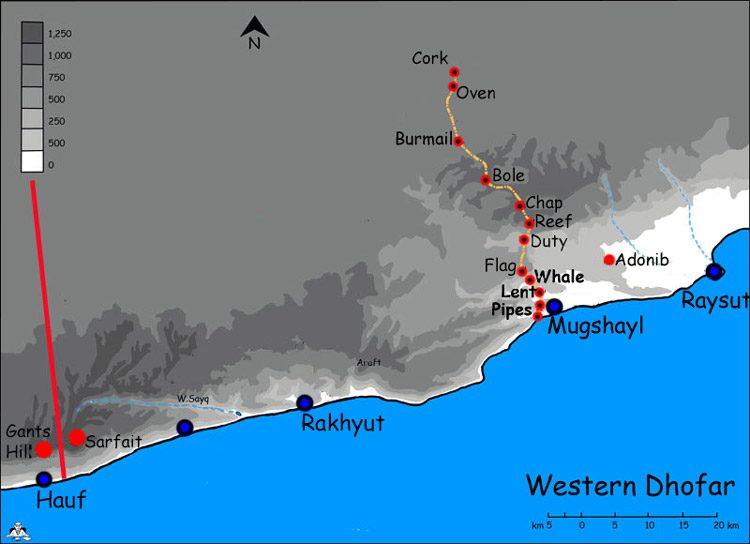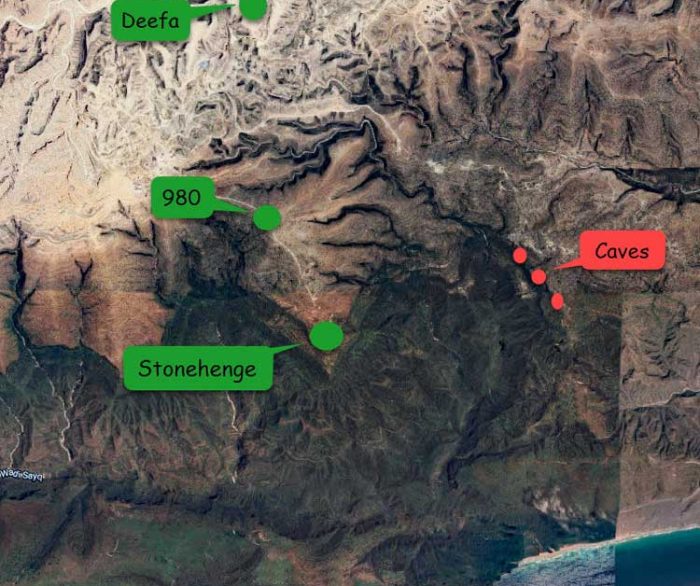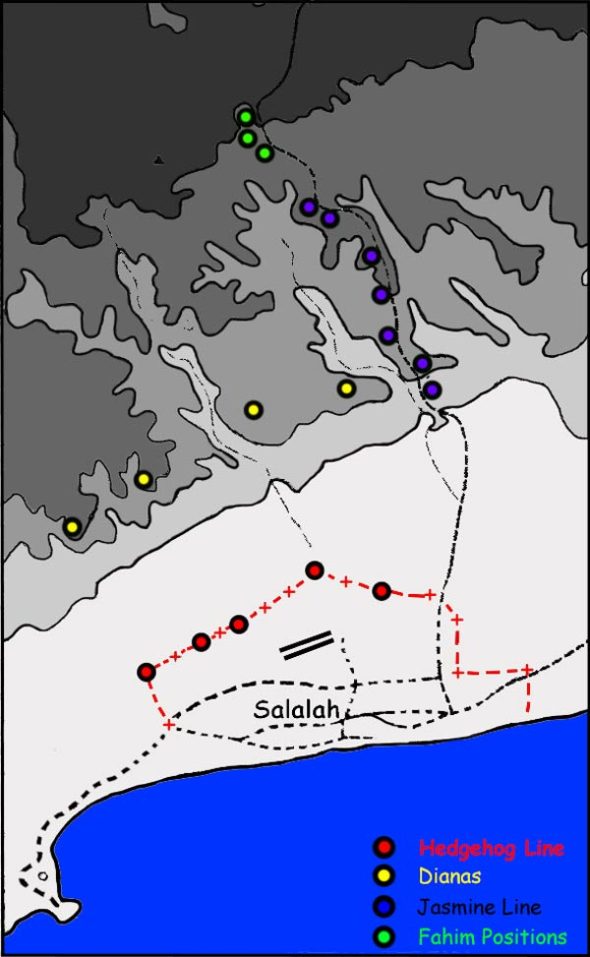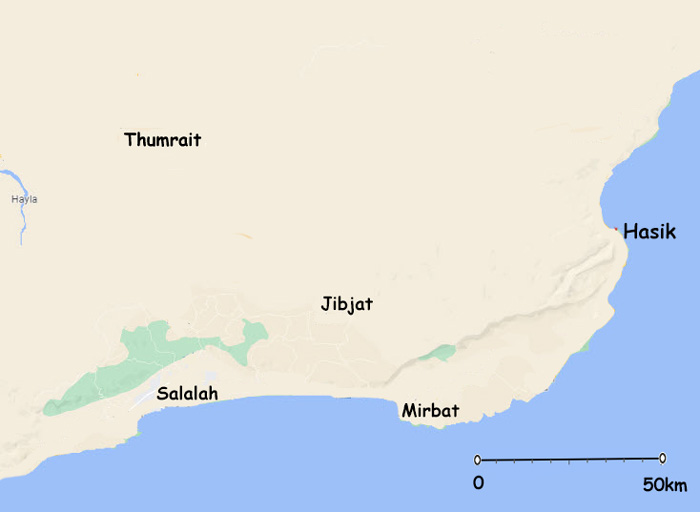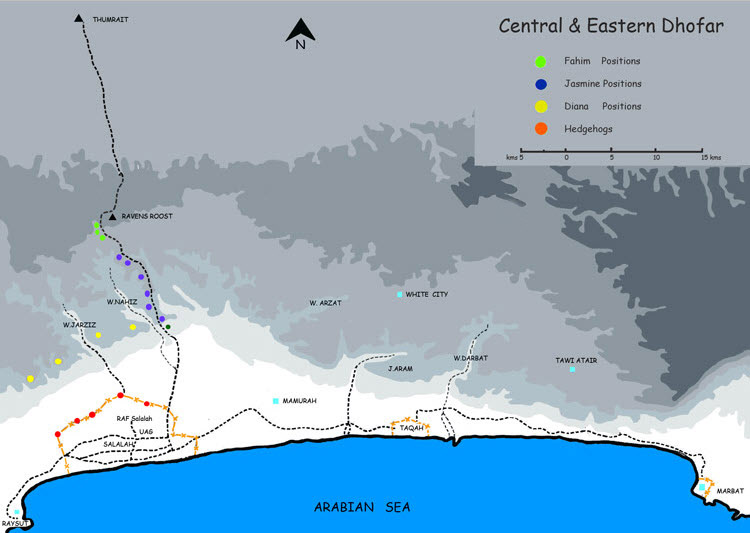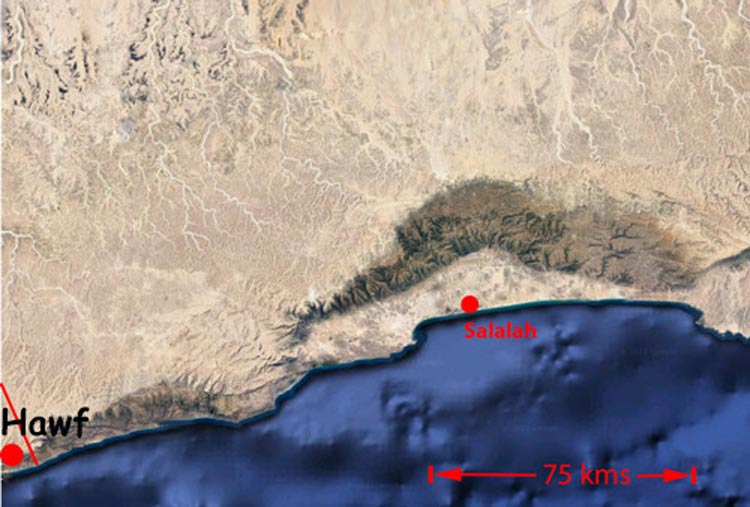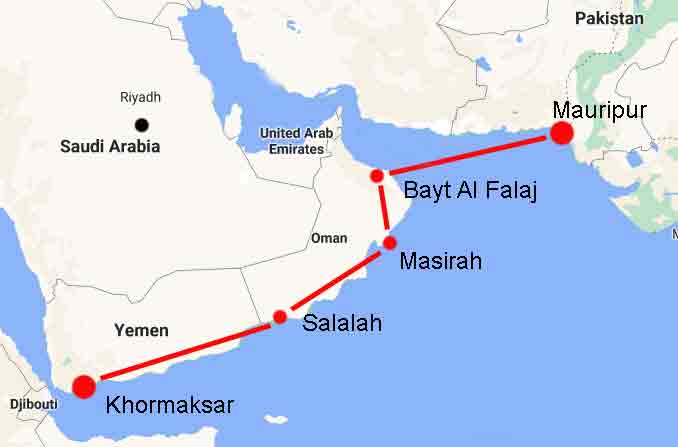
What happens when the wells run dry ?
by Nicholas Wollaston in Muscat
Inside the fortress at Nizwa, up in the mountains of northern Oman, a fettered prisoner hopped across the sun-baked courtyard to the well. His ankles were linked by a bar of iron and he could only lope along, rather like, a hobbled camel, except that a camel’s legs are usually bound with rope, not iron.
I wasn’t meant to have seen him. The guard wouldn’t let me question him or photograph him, and my Omani companions hustled me up a stairway to admire, the view from the ramparts, hoping that I would forget him. When I persisted, they laughed him off as just some silly fellow who had probably insulted the Koran by drinking alcohol and been caught.
Contrasts abound in Oman, the cliches of a country that has passed from the mediaeval to the modern in seven years. Outside the fortress walls in Nizwa market, among melons, spices and pocket calculators and goatskins and briefcases, a group of tribesmen squatted entranced around a merchant who had just unpacked a box of Chinese mechanical toys. A veiled housewife haggled over Heinz Tomato ketchup, while above the lovely, pale, flat-topped old houses, now bristling with colour TV. aerials, a jet fighter thundered through the bright Arabian sky.
The people of Oman have got off their camels and into their Toyotas without bothering about the bicycle stage. Led by a young Sultan, sustained by their own equanimity, helped plentifully from the outside, they have gone through the 20th-century sound-barrier and emerged with an attractive ragbag of the past and the present. The future is something they have hardly had time to consider.
The perfumes of Arabia, now smothered by the fumes of oil, lingered in Oman longer than elsewhere. Cut off by the terrible sands of the Empty Quarter, its merchants looked to trade to India and East Africa rather than to their Arab cousins in the north. They sailed their dhows to Ceylon and Zanzibar, they sent their sons to school in Bombay sooner than in Cairo. Oman is the second biggest state in Arabia, after Saudi, but in 1967, when it became the latest member of the oil producers’ club, there was a lot of catching up to do.
Not much was done until 1970 when the previous Sultan, an old-fashioned potentate famous for his conservatism, fled to London to be treated for bullet wounds-some say in his foot and stomach, others say only in his buttocks. His son Qaboos, a product of Sandhurst, moved into the palace and set about sweeping out the cobwebs. In seven years the change has been astonishing.
A visitor to Muscat, the little capital, with its twin town of Matrah, may feel he has been dropped into a quarry or a vast building site. A smell of cement hangs over it, with a roar of lorries, stone-breakers and bulldozers. In the glare and beat of noon, even the unremitting stony mountains that crush the town into a narrow foothold along the coast seem to be still under construction, as if the finds ran out and they were never finished. Only when, they are softened with shade and colour by the falling sun, before it drops suddenly behind them into the desert, do they look like real mountains. At that hour, to complete the magic, a circle of old watch towers appears on the tops.
Side by side at the head of Muscat bay, guarded by a splendid pair of forts, lie the Sultan’s palace and the British embassy – the one gaudy and recently remodelled, the other restrained and dignified with a verandah courtyard and a portrait gallery of confident English faces up its wide wooden staircase.
The position and proportions of the two buildings are symbolic. For nearly 200 years we have kept an imperial and post-imperial eye on the fortunes of Oman, and recently, with those fortunes boosted to the skies, the gaze has been returned. Six thousand British people work now in Oman, and a trickle of Omanis have come to buy houses in Britain. A weekend in London is more than a dream for several Muscat businessmen.
After Sultan Qaboos’s coup in 1970, many of the Omanis who preferred to live abroad during his father’s repressive reign went home. Oman could hardly have done without them, and any Cabinet Minister or under-secretary, with turban and long white gown and immense hooked dagger stuck into his belt, is likely to have spent most of his working life in another country. (The swashbuckling, costume, is exactly suited to the relaxed aristocratic civility which, with a whiff of coffee laced with cardamom, pervades the corridors of Muscat.)
But of course the Omanis, despite the help of Europeans and other Arabs, could never have made such progress without imported labour. Schools, roads, hospitals, mosques, harbours, shops, garages whatever is built the men who get their hands dirty, are almost all Indians and Pakistanis. An Omani will leave manual work to someone else – not because it was traditionally the job of slaves, or because as a warrior he ought to be sitting under a tree with a rifle, or because £50 a month is not enough, but because there is simply no need ;for him to consider it.
Flying over Oman is like flying over a very big, very old chapatti. After the northern mountains, where the soft greens and duns of a rare village are the only relief, the dazzling gravel desert stretches from the Indian Ocean to the ferocious seas of sand. It is criss-crossed by tracks of goats and camels, bedouins and oil prospectors but nobody knows how many people live in Oman. The Sultan’s guess is a million and a half, cautious foreigners say that he has at least doubled the figure.
At Salalah in the Dhofar Province, 500 miles from Muscat, the scene is altogether different. Groves of palms and fields of crops catch the monsoon rain and people speak with resentment, even contempt of the northeners. History and emotions link Dhofaris with the Hadramhaut and Yemen and Aden, not with Muscat.
Two years ago the war in Dhofar was declared finished, and although 60 or 70 rebels are still at large, they have been cut of from their Communist masters in the Peopl&s Democratic Republic of Yemen. The frontier west of Salalah, in breathtaking country with no roads and almost no water, is defended by a battalion of the Oman Army commanded by a British colonel in a turban.
I arrived at his wilderness HQ by helicopter, with a British pilot, slipping up the narrow wadis and keeping below the skyline so as not to provoke the Yemenis -making sure the morning sun is behind us. We brought meat and water barrels slung in a net under the fuselage (the battalion uses donkey transport between its outposts).
Beside us a cliff dropped a thousand feet to a wide ledge of scrubby forest, beyond which another cliff dropped into the sea. As the colonel said, it was old-style soldiering, good NorthWest Frontier stuff and a rare treat for anyone in the modern Army; but sadly his time, was up and an Omani officer had already been appointed to take command.
After breakfast the colonel took me by helicopter to some of the positions up and down the line, diving down a gully, soaring up a cliff face, settling on a flattened patch of stones. Young British officers and their troops, manning spectacular but lonely sectors of the frontier, greeted us and gave us tea, while through binoculars I watched the enemy, a thousand yards away, watching me.
All is quiet, but occasionally a disenchanted soldier walks across from the Yemen side and surrenders. After debriefing for news of Russians and Cubans and East Germans (the Chinese have gone home) he is often given a new-rifle and enrolled in a firquat, the irregular Omani militia. Loyalty. even in Arabia, has a price. Recently a man gave himself up to the battalion, a veteran of several armies who had not only been trained at Aldershot but had attended an English language course at the same, Army school where the British colonel had learnt his Arabic.
There are six hundred British officers serving the Sultan of Oman, a third of them on loan from the British Army the rest on private contract (“ mercenary” is a dirty word). In a country so riven with tribalism, it seems quite proper that the commander of the Army should be all officer of the Inniskillings called General The O’Morchoe – a chieftain himself, a sort of Irish sheik – but the General is no romantic Irish imperialist. “Omanisation” is his mission, though with no Omani officer having a University degree and very few having any secondary education, it will be many years before the Sultan can send his British soldiers home.
In many ways the Sultan is a fairy-tale prince brought up to date. He is handsome, he has only one wife, he likes horses and yachts and beach buggies and holidays at Gleneagles and regimental marches. Being a military man, also a ruler answerable to nobody, he prefers swords to ploughshares and recently he bought himself an extravagant defence system complete with Jaguar fighters ,and Rapier missiles.
To his northern neighbours, as gatekeeper of the gulf he must be a comfort. With a Communist state next door and turmoil in the Horn of Africa, he can count on friendship from the rich oil producers who need his stability for the safety of their exports. To his subjects that stability – a mask for. Autocracy – is a questionable advantage, though few would dare to question it.
The Sultan is his own Prime Minister, Defence Minister and Foreign Minister. He allows no political opposition, no critical Press, no elective system, no assembly in which the people, can be heard.
His birthday is the annual National Day, November the 18th when shiny new enterprises are first expected to be finished, or anyway opened. Next Friday he will be, honoured by the completion of an immense stadium, an airport, two luxury hotels and several fountains, as well as triumphal arches of wood and bunting decorated with slogans, and fairy lights. For the occasion, a suburb was bulldozed to the ground one recent afternoon, to make, way for the visitors’ cars.
There are the makings of tragedy in Oman. It is 10 years since the oil pumps started up, and already the flow, never mere than, a drop in the total Gulf supply, has passed its peak. In 10 more years it may run dry and the Omani oilfields will be the first to go through the cycle of exploration, discovery, production and exhaustion.
Meanwhile, in, the, prosperity of new Oman, precious features of old Oman get lost. Water, more vital than oil but also in uncertain supply, has been conserved for centuries by a remarkable system of conduits often under ground; Many of them now neglected by Omanis having money to drill boreholes indiscriminately heedless of falling water tables the seepage, in, coastal places, of sea water.
There is talk of more desalination, but it needs a lot of fuel. There is talk of further new oilfields, of natural gas, of copper and several other unknown riches as alternatives to oil, just as there is talk of improving old industries like farming and fishing. There is plenty of talk, but nobody seems very troubled that so little is done while it can still be paid for.
The Omanis are some of the nicest possible people friendly easy-going, orderly, courteous but hardly dynamic; and if they haven’t done much to bring the present boom upon themselves they are not doing much more to avoid the disaster that could come afterwards.
One of the things that happened was that, even before the wells had run dry, the PDO got together with BP and developed the “Khazzan” field to produce LNG and condensates. It appears to contain 100 trillion cubic metres of gas and came on stream in 2017 and is owned 60% BP and 40% Oman Oil.
The gas is “tight” and requires hydraulic fracturing to release it.
The field however is managed in an environmentally sensitive way.
The next present the geophysicists came up with for sultan Qaboos was the “Mabrouk” gas field. This is still being assessed but is thought to contain an almost equal amount of gas and condensate.
The creation and development of a diverse infrastructure with reliance on not just one but on many different activities seems to have put aside Nicholas Wollaston’s many gloomy prognostications and worries about “What will happen when the wells run dry ?” Just as long as South East Asia requires energy…..
Lorem ipsum dolor sit amet, consectetur adipiscing elit. Ut elit tellus, luctus nec ullamcorper mattis, pulvinar dapibus leo.
